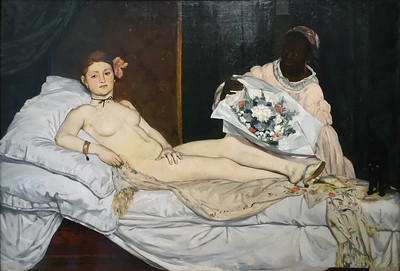No products in the cart.
January 23, 2022
Édouard Manet was a controversial artist throughout his life. Artistically, he went his own way and could not be pigeonholed. This earned him admiration from some and contempt from others. He himself expressed it like this:
"I paint what I see and not what others choose to see."
Édouard Manet would have been 130 years old today.
His paintings are attributed to Impressionism, even though Manet did not consider himself an Impressionist. Despite several invitations, he did not take part in a single Impressionist exhibition. The "Paris Salon" was the place where he wanted to exhibit. However, his works were not always accepted there. Manet received praise mainly for his portraits and still lifes, for other paintings he earned ridicule or even insults.
From the 1870s onwards, he devoted himself to painting modern, bourgeois life. He found his motifs on the streets, in the cafés and upper-class homes of Paris.

Édouard Manet, Olympia, 1863, oil on canvas (Musée d'Orsay, Paris)
The 1863 painting Olympia is one of the French painter's major works.
The reclining, unclothed woman has a long tradition as a motif in art history, so one would think that the painting would have given little cause for scandal. And yet, it caused one of the biggest uproars in art history.
Until then, either religious or mythological backgrounds served as an "excuse" for nudity. Manet dispensed with this. He painted a prostitute and he did not dress it up.
Moreover, Olympia looks at the viewer with self-confidence. She does not cast down her gaze, is not bashful. Her depiction is neither offensive, nor vulgar, not even particularly sensual. She shows Olympia as a woman who is aware of her charms and who is willing to use them to her advantage. This turns her from a (sex) object into a self-determined being. A role that women in general and prostitutes in particular did not have at that time.
In addition, there are scandalous symbols in the imagery: the bouquet of flowers from an admirer that the black servant brings in is a gift of love. The orchid in Olympia's hair symbolises an aphrodisiac. Pearls are associated with Venus, the goddess of love, and the cat stands for erotic debauchery. This probably explains the strong reactions to the painting.
"When Olympia's dreaming then comes to an end,
Spring comes in the sweet messenger's black arm.
She was destined to be a slave in the night of love,
But in the daytime she'll celebrate the beauty of her eyes:
The noble woman in whom the flame glows."
Poetry by Zacharie Astruc after seeing the painting.
When the painting was exhibited at the Paris Salon in 1865, crowds gathered in front of it. It is ridiculed, mocked and insulted. Eventually it even has to be hung out of reach. The predominantly male visitors threaten to beat it with walking sticks and umbrellas.
Manet's Olympia is now French state property and is exhibited in the Musée d'Orsay.
The Olympia theme was taken up again and again. First by Paul Cezanne, but Gerhard Richter and many others were also inspired by the painting. Olympia in particular also ensures that Manet is considered by many art historians to be the founder of modern painting. His art was new, modern, unconventional and permissive. His motifs were profane; he depicted daily, if privileged, life.
After his early death - his leg had to be amputated due to syphilis, which he survived only 10 days - his work gained attention and recognition.
Join the newsletter now
and not miss a thing
Get exclusive insights into my creative processes, learn the stories behind my artwork
and receive invitations to my exhibitions and events.
To say thank you, I'll give you 10% off your first purchase.